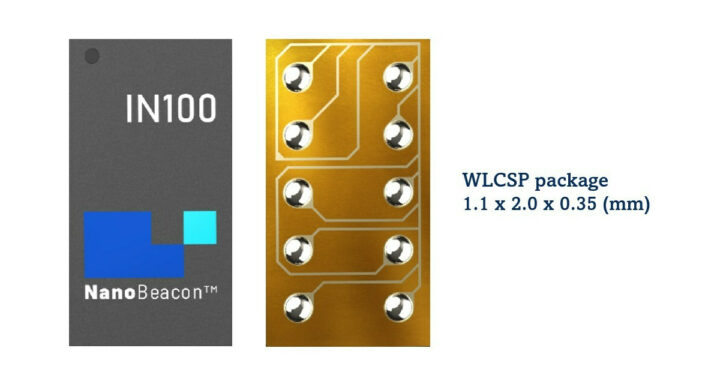InPlay has just announced a Wafer Level Chip Scale Package (WLCSP) for its NanoBeacon SoC IN100, making it the world’s smallest Bluetooth System-on-a-Chip (SoC) at just 2.0 x 1.1 x 0.35mm.
The NanoBeacon IN100 is not new per se, and we covered the still tiny Bluetooth SoC when writing about Sparkfun NanoBeacon Bluetooth 5.3 module based on the DFN8 package measuring 2.5×2.5mm. The highlights include its low-code/no-code interface and an ultra-low power consumption of below 1 uW.
 InPlay NanoBeacon SoC IN100 specifications:
InPlay NanoBeacon SoC IN100 specifications:
- Memory – 4 KB SRAM + 4 Kbit OTP memory
- Bluetooth 5.3 compliant
- Beacon Modes: Proprietary, BT, Google Eddystone, and Apple iBeacon compliant
- 2.4GHz RF frequency band, MedRadio band (2.36GHz)
- Programming-free and firmware-less design
- Long-range transmission: up to several hundred meters
- Security
- Authentication of beacon ID
- Privacy of advertising payload
- Supply voltage range – 1.1V ~ 3.6V (Single 1.5V coin battery support)
- Power consumption
- Sub-uW power consumption for multi-year operation on a tiny battery
- Sleep current: 650nA (with RC on)
- Package – WLCSP10: 2.0×1.1×0.35mm; DFN8: 2.5×2.5mm; QFN18: 3x3mm
- Temperature Range – -40°C ~ 125°C
The new tiny WLCSP IN100 Bluetooth SoC is expected to be used in a range of applications:
- Printable tags for asset tracking thanks to its ultra-thin form factor
- Healthcare data broadcast via wearable health monitoring devices, such as smart patches or wristbands.
- Smart textiles where the NanoBeacon IN100 is integrated into sports gear or uniforms to transmit performance stats or environmental conditions.
- Miniature drones – The small footprint and light weight of the NanoBeacon IN100 make it suitable for tiny drones that broadcast location, telemetry, or other data.
- Smart jewelry that can rely on the NanoBeacon IN100 to broadcast user-defined data such as emergency contact info or health data, without compromising on style or comfort.
The product page has more detail about the chip, but it has not been updated with the new WLCSP package, and neither has the datasheet linked on the page. At this time, only the press release includes information about the WLCSP IN100 Bluetooth SoC.
Thanks to TLS for the tip.

Jean-Luc started CNX Software in 2010 as a part-time endeavor, before quitting his job as a software engineering manager, and starting to write daily news, and reviews full time later in 2011.
Support CNX Software! Donate via cryptocurrencies, become a Patron on Patreon, or purchase goods on Amazon or Aliexpress




